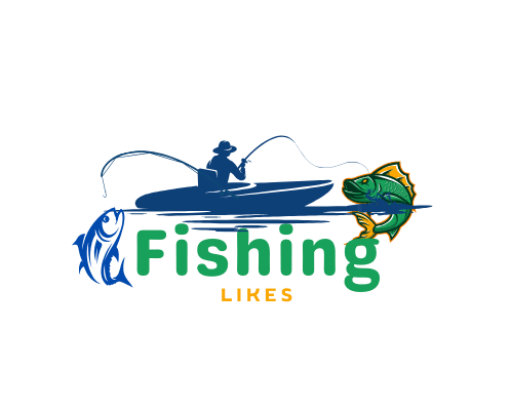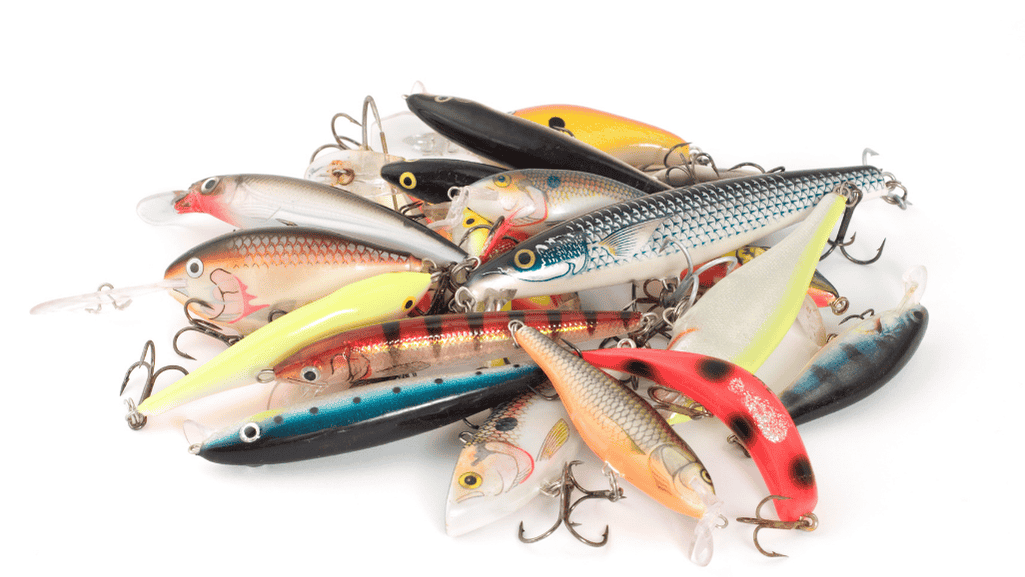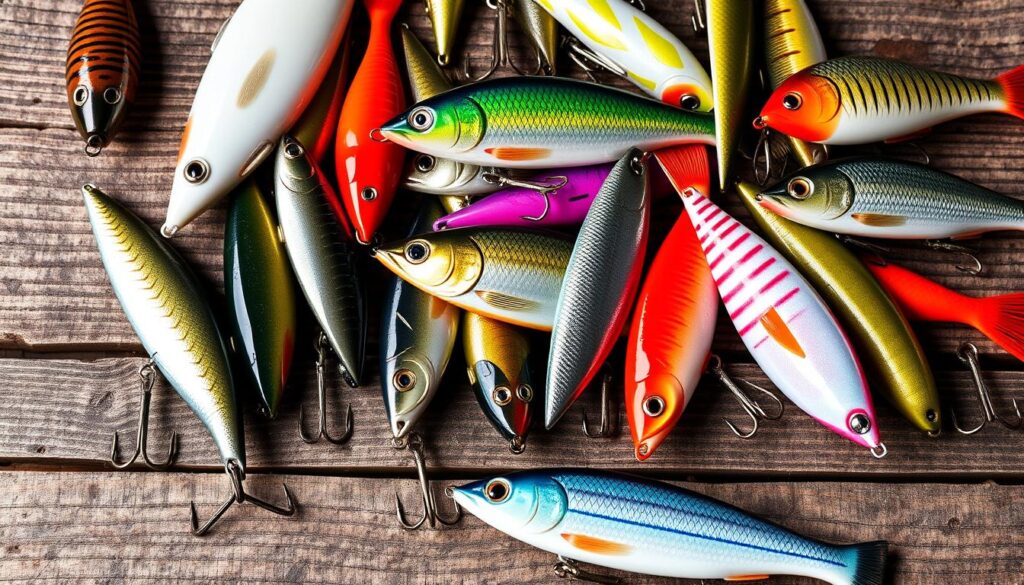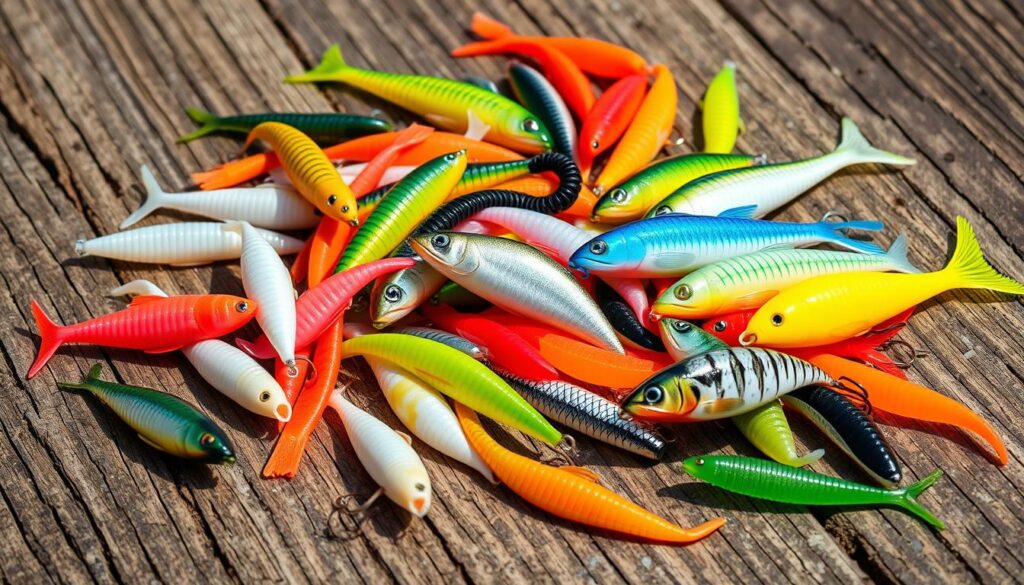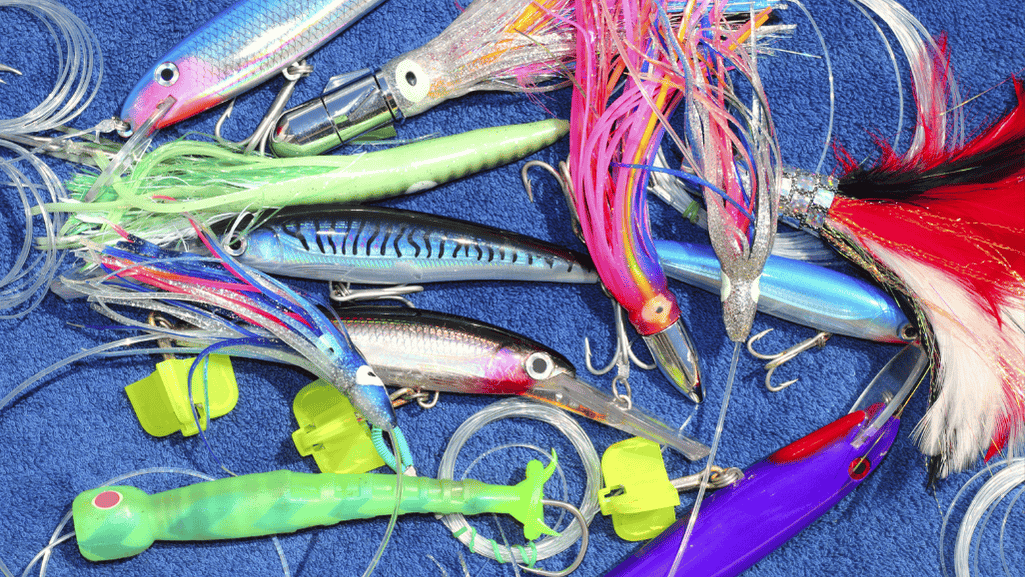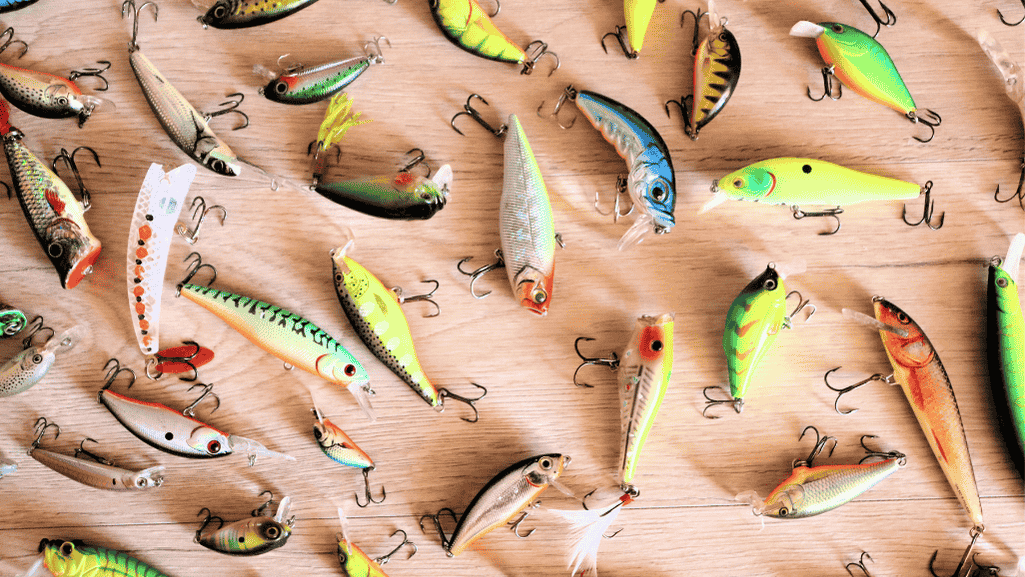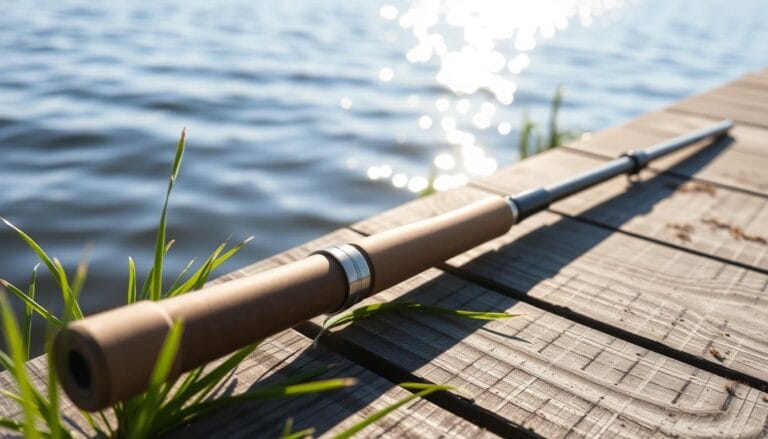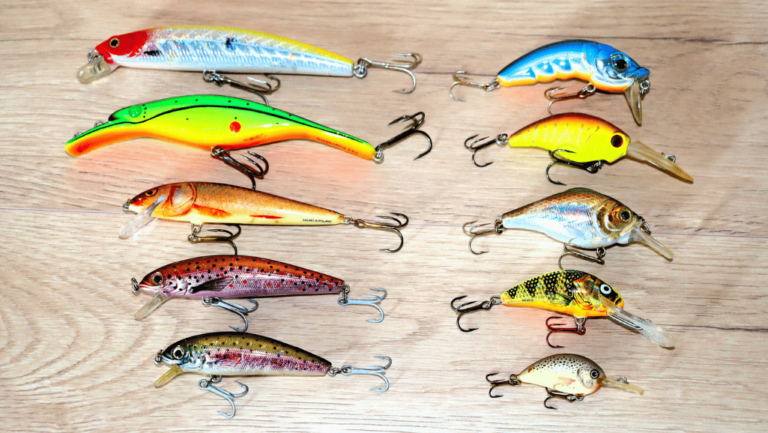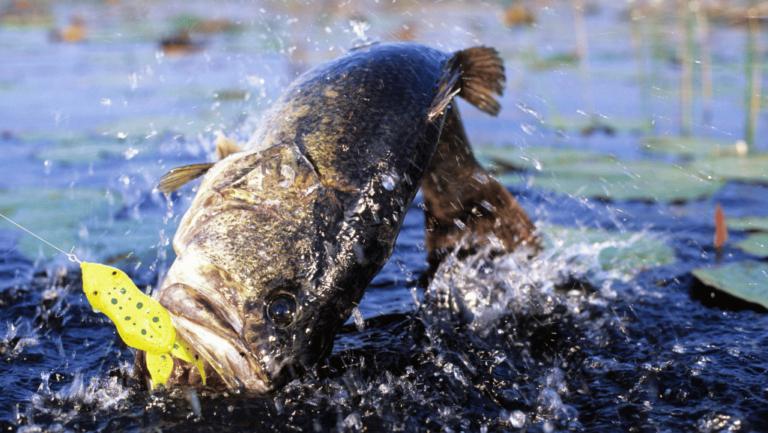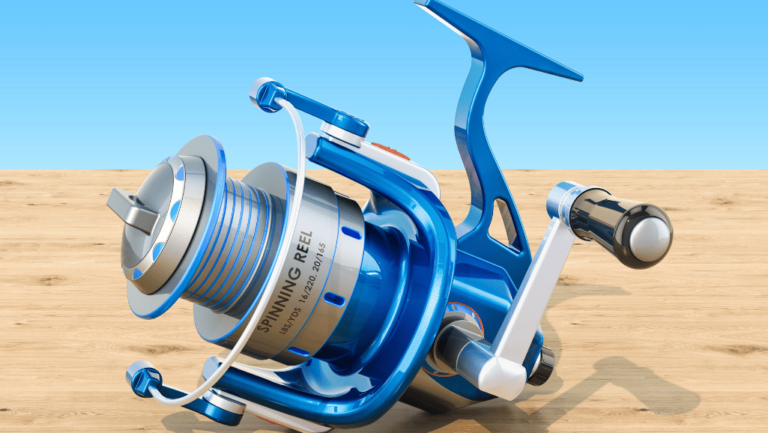Striped bass, also known as rockfish or stripers, are highly sought after in North America. Anglers need the best lures to mimic their natural prey. The right lures are key to enticing strikes and catching big fish.
Many effective lures for stripers have been created over the years. These lures work well in different conditions and places. Whether you like hard baits or soft plastics, there’s a lure for every situation.
Choosing the right lures involves knowing the fish’s habits and what they eat. By understanding this, you can pick lures that look like baitfish. This will make the fish more likely to strike. With the right lures, you can fish in various depths and water types with confidence.
Key Takeaways:
- Choose lures that resemble the movement and appearance of striped bass prey
- Consider classic designs and modern innovations for effective striped bass fishing
- Match lures to specific conditions, habitats, and feeding preferences of stripers
- Employ a variety of lure types, including hard baits and soft plastics, to cover different depths and water clarities
- Understand seasonal patterns and migration habits to select the best lures for striped bass success
Understanding Striped Bass Behavior and Lure Selection
To catch more striped bass, knowing their behavior and choosing the right lures is key. Striped bass, or stripers, move with the seasons and eat what’s available. Using the right lures can help you catch big ones.
Seasonal Patterns and Migration Habits
Every spring and fall, striped bass migrate thousands of miles. They move in search of food and the best places to breed. In May, they swim up rivers in big schools.
They live in coastal waters, estuaries, and rivers. They like water between 55-68°F. Knowing this helps you pick the best gear and spots to fish.
Feeding Preferences and Prey Imitation
Striped bass eat many things, like bunker, mackerel, and shrimp. It’s important to pick lures that look and move like their food.
For example, when bunker are around, use swimbaits or jerkbaits. During shrimp migrations, soft plastics work well. This way, you can imitate what they’re eating.
“Matching the hatch is key when it comes to striped bass lure selection. Pay attention to the prevalent baitfish in the area and choose lures that closely resemble them in terms of size, color, and action.” – Capt. John Luchka
Understanding striped bass behavior helps you choose the right lures and techniques. Whether fishing in the surf or estuaries, matching your lures to the conditions and prey will improve your chances.
Top Hard Baits for Striped Bass
Hard baits are key for catching striped bass. They come in many styles, sizes, and colors. This lets you mimic baitfish and attract bass in different conditions. Poppers, diving plugs, jerkbaits, and lipless crankbaits are top choices, each for different depths and baitfish behaviors.
Topwater Lures: Poppers, Walk-the-Dog Baits, and Pencil Poppers
Topwater lures are exciting and draw bass to the surface. Poppers like the Yo-Zuri 3DB Popper and Rebel Jumpin’ Minnow make a splash. Walk-the-dog baits, like the Daiwa SP Minnow, mimic fleeing baitfish. Pencil poppers offer a mix of surface disturbance and erratic movement.
Subsurface Lures: Diving Plugs, Crankbaits, and Jerkbaits
Subsurface lures are great for bass holding deep. Diving plugs dive to specific depths. Crankbaits mimic injured baitfish with their wobbling action. Jerkbaits have a darting motion when twitched or jerked.
Lipless Crankbaits and Rattling Lures
Lipless crankbaits and rattling lures cover water fast. They attract bass from afar with their loud rattle. The Sebile Action First Lipless Seeker and Bill Lewis Rat-L-Trap are good examples. The Heddon Super Spook Jr. and Rapala Skitter Walk are also effective, especially in clear or stained water.
Choosing the right lure colors and patterns is crucial. Consider water clarity, sunlight, and local baitfish. Natural colors like white, silver, and olive are reliable. Brighter colors like chartreuse and hot pink work well in murky or low-light conditions. Try different rigging techniques to improve your chances.
Best Soft Plastic Baits for Striped Bass
Soft plastic baits have changed the game in striper fishing. They offer a versatile and effective way to catch striped bass. You can choose from small 3-inch baits to big 12-inch ones, matching the size of the fish you’re after. When fish get picky, using smaller 4- to 7-inch unweighted soft plastics can help.
The paddle tail swimbait is a favorite for catching striped bass. It looks like a fleeing baitfish, making it very appealing. Lures like the Storm WildEye Swim Shad and Berkley Havoc Grass Pig have a paddle tail that vibrates, drawing in stripers. They work best with a jighead, helping you cover more water and reach fish at different depths.
Paddle Tail Swimbaits and Shad Imitations
Paddle tail swimbaits and shad imitations are key for catching stripers. They look like the natural food these fish eat. Soft plastics like the Zoom Super Fluke and Keitech Swing Impact mimic baitfish well. White soft plastics are often the best choice, but try different colors to see what works best in your area.
Jig Heads and Soft Plastic Combinations
Choosing the right jig head is important for the right presentation. Jig heads range from 3/8 ounce to 1 ounce, and hooks from 6/0 to 8/0. Paddle tails and split tails work great on a jig head, offering different vibrations to attract fish. For deep water, you might need heavier jig heads to handle the drag of larger soft plastics.
Weedless Rigging Options for Shallow Water Fishing
In shallow water, weedless rigging is key for avoiding snags. Techniques like the Texas rig help you fish through heavy cover without getting stuck. Weedless hooks, like the Owner Twistlock, are made for this, allowing you to fish through thick vegetation smoothly.
Soft plastic baits are a favorite among striper fishing fans. They offer a wide range of options for catching these strong fish. By choosing the right paddle tail swimbaits, jig heads, and rigging, you can mimic different prey and adapt to any fishing situation. This makes soft plastics a must-have for any striped bass fishing rig.
Trolling Lures and Techniques for Striped Bass
Trolling is a top method for catching striped bass in open water. It makes up about 80 percent of all striped bass trolling. Anglers use trolling to cover large areas and reach deep where big fish live. Striped bass like to be near rips, rocks, and shorelines, making these spots great for trolling.
To catch striped bass by trolling, you need the right gear. An 8’6″ medium heavy Daiwa Wilderness rod and an Okuma Coldwater line counter reel are good choices. Use 30lb Power Pro braided line for its sensitivity and 30lb Berkeley Trilene Big Game mono line for its strength. Shorter rods help reduce wind drag and improve performance.
For productive striped bass rigs, umbrella rigs and swimbaits are top picks. Umbrella rigs look like a school of baitfish, drawing in stripers. Swimbaits like the Storm Wildeye and Optimum Baits Bad Bubba are known for their realistic action and ability to attract big fish.
Umbrella Rigs and Parachute Jigs
Umbrella rigs, with their multiple hookless teasers and trailing hook bait, are favorites for striped bass. They look like a school of baitfish, which triggers stripers’ hunting instincts. Mojos, large bucktail jigs with a reverse-tied hair skirt and a lead head, are also popular for trolling. They allow anglers to fish at different depths and present a big profile that attracts trophy-sized stripers.
Spoons and Bunker Spoons
Spoons, especially bunker spoons and heavy-duty trolling spoons, are great for saltwater angling. They mimic the flash and movement of injured baitfish, making them hard to resist for striped bass. When trolling with spoons, consider the speed and depth. The best speed is under 3.5 knots, adjusting based on fish activity.
Using devices like Fish Hawk or observing the bottom in muddy waters helps find the best depth for your trolling rig. By dropping in and out of gear, anglers can reach depths of up to 60 feet.
For deeper waters, add a drail between the leader and the running line, with drail weights from 4 to 8 ounces. Running plugs on wire line with a 20- to 30-foot long leader works well in deep water. Lures like SpeedLure 130’s and LuckyCraft Pointers, with their slower wobble, are good for a natural presentation.
By using these proven striped bass lure patterns and trolling techniques, you’ll have a great chance of a successful day of striper fishing on the open water.
Matching Lures to Specific Conditions and Habitats
To catch striped bass, you need to pick the right lure for where you’re fishing. The right striped bass lure can make a big difference. It can help you catch more fish and make your fishing trips better.
Surf Fishing Lures for Stripers
For surf fishing, choose lures that can handle the rough conditions and go far. Some great surf fishing lures for stripers are:
- Metal lip swimmers
- Pencil poppers
- Heavy spoons, like the Acme Kastmaster Spoon in silver and blue, silver and chartreuse, or gold
These lures can cut through wind and waves. They help you reach fish far away and attract them with real-looking presentations.
Inshore and Estuary Lure Selection
In inshore and estuary areas, pick lures that look like local baitfish. Good choices for shallow water and edges include:
- Paddle tail swimbaits
- Jerkbaits
- Soft plastic jigs, like the white Bucktail Jig
Choosing a lure that looks like the baitfish in the area will attract stripers.
Adapting to Water Clarity and Depth
Water clarity and depth matter a lot when choosing striped bass angling gear. In murky or deep water, use bright colors and loud lures. Lipless crankbaits in black back chrome or bone white work well. They mimic schools of baitfish and attract bass.
In clear, shallow water, use natural colors and quiet lures. Jigs and soft plastics that look like crustaceans or baitfish are good. They imitate the stripers’ natural food.
By thinking about the conditions and habitats you’re fishing in, and picking the right lures, you’ll catch more striped bass. This will make your fishing trips more fun and successful.
Conclusion
When fishing for striped bass, it’s crucial to have the right lures and know when to use them. Lures like the Atom Popper create a lot of commotion on the surface. Soft plastics, such as Gulp Jerk Shad and Paddle Shad, mimic the movements of baitfish.
Choosing the right lures depends on the season, what the fish like to eat, and where they live. By picking lures that fit these conditions, you can catch more striped bass. This is because you’re imitating their natural prey and presenting it in a way they can’t resist.
Having a variety of lures is important. Include lures like the Spro bucktail jig and Kastmaster spoons in your collection. These are proven to work well. Also, don’t forget the Rapala X-Rap Extreme Action Slashbait for trolling.
Learning how to use these lures effectively will make your fishing trips unforgettable. It’s not just about the gear; it’s about how you use it. Pay attention to the size of the fish, the depth of the water, and the current. This will help you choose the right lure and presentation.
As you go on your fishing adventures, always be ready to try new things. Adapt to the changing conditions and preferences of striped bass. This way, you’ll make the most of every fishing trip and have a chance to catch a trophy striper.
With the right lures and a bit of practice, you’ll be able to make lasting memories on the water. You’ll become a skilled striped bass angler, joining the ranks of those who have successfully caught these impressive fish.
